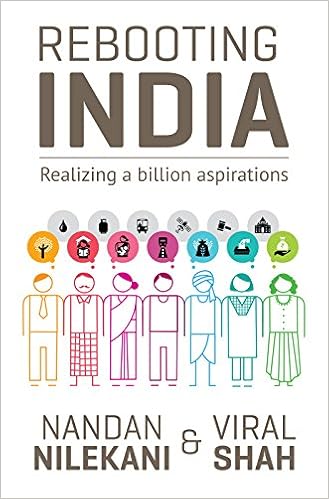
 ebooting India by Nandan Nilekani and Viral Shah is an excellent discussion of how, and under what circumstances, Aadhaar got conceived and its meaningful extensions to improve the manner in which the Indian Government can enrich the life of its citizens.
ebooting India by Nandan Nilekani and Viral Shah is an excellent discussion of how, and under what circumstances, Aadhaar got conceived and its meaningful extensions to improve the manner in which the Indian Government can enrich the life of its citizens.The book is a bold attempt to infuse technology as a foundation for governmental and societal efficacy, by rooting out opportunities for fraud, bribery, leakage, etc. (I'm poignantly familiar with the strikes against computerization labor unions held in the early 1970s that technology was to be eschewed: Why? It'd rob the unionists of 'meaningful' employment, of course, ...)
The book has 16 chapters of which Chapters 1-2 are about Aadhaar, the concept and its implementation, Chapter 16 is a conclusion and Chapters 3-15 describe additional Aadhaar and related usages, including the most basic: Banking on Government Payments.
Two particular applications in particular are noteworthy for highlighting the advantages of a direct benefit transfer system: Goods and Services Tax (GST), and Electronic Toll Collection (ETC) system.
Nearly every chapter starts off with a story that every [Indian] person can easily relate to.
An important underpinning of the book is the exposure one gets to know about how the Indian Government works through many of its committees, etc. It unravels the complexity that any scalable solution — affecting India's current population of 1.2 billion — ends up facing in the Indian context and that, too, where the Government needs to be involved of necessity. Perhaps Nandan's background, as a former Infosys' CEO, has been a particularly valuable prior experience in tying together the various governmental entities, at times quite disparate.
Another message that is evident throughout the book is how traditional hierarchical thinking — in governments, in particular — is against meaningful progress. While this is something Agile practitioners have been noting for quite some time — See, for example, Can A Big Old Hierarchical Bureaucracy Become A 21st Century Network? — what is interesting in this book is to that it describes solutions that circumvent the stifling that governmental bureaucracy can create.
A very useful book to study, certainly for anyone that wants to create an IT-centric solution for the pan-Indian market.
An important underpinning of the book is the exposure one gets to know about how the Indian Government works through many of its committees, etc. It unravels the complexity that any scalable solution — affecting India's current population of 1.2 billion — ends up facing in the Indian context and that, too, where the Government needs to be involved of necessity. Perhaps Nandan's background, as a former Infosys' CEO, has been a particularly valuable prior experience in tying together the various governmental entities, at times quite disparate.
Another message that is evident throughout the book is how traditional hierarchical thinking — in governments, in particular — is against meaningful progress. While this is something Agile practitioners have been noting for quite some time — See, for example, Can A Big Old Hierarchical Bureaucracy Become A 21st Century Network? — what is interesting in this book is to that it describes solutions that circumvent the stifling that governmental bureaucracy can create.
A very useful book to study, certainly for anyone that wants to create an IT-centric solution for the pan-Indian market.
Today, we read that PM Narendra Modi wants integration of all land records with Aadhaar.
ReplyDelete